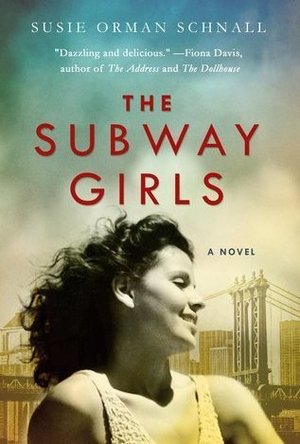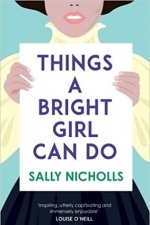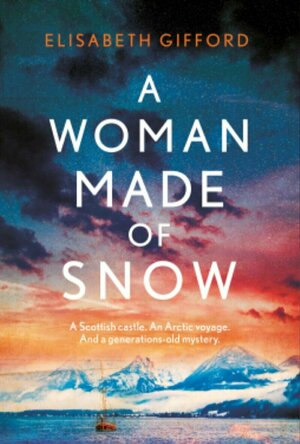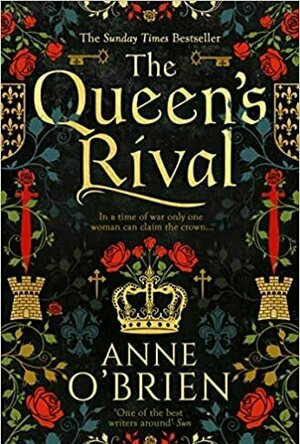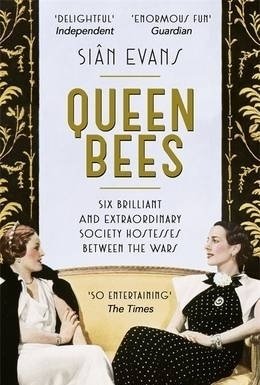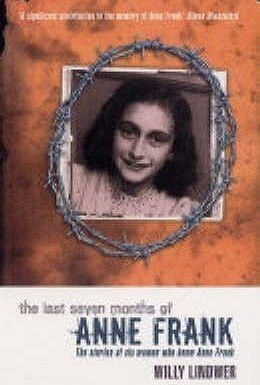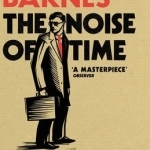Search
Search results
Amanda (30 KP) rated Hidden Under Her Heart (Chance for Love, #2) in Books
Jun 21, 2018
As someone who is prochoice and not religious, I could have lived without the "God doesn't want you to kill your baby bits". Other than that, the story was pretty riveting. I do wish that Maryanne would have gotten a rape kit done at the hospital. Like many women, she was too afraid and was afraid of having to give her history out to her coworkers (she was a nurse). I was also a little sad that we didn't find out who Emma's father was in the end. I have a sneaking suspicion that it was Barry's child, since he worked so hard to "get rid of the evidence".
Bookapotamus (289 KP) rated The Subway Girls in Books
Jul 9, 2018
Charming, interesting and Girl Power!
Soooo charming and loads of girl power!!
The Subway Girls had me roped in from the second I heard about the story. Being in advertising, having lived in Brooklyn, and ALL about being a strong, independent and confident chick - I soared through this book and cannot believe I didn't know about this campaign before! Now, I'm gobbling up every book and article across the internet about it!
The Miss Subways campaign was basically a beauty/modeling contest, which translated into posters of beautiful women splashed across subway as advertising to encourage New Yorkers to ride. But it was also so much more than that. It opened doors for these women, when there weren't many available. Some went on to modeling careers, while others went back to their quiet lives at home with their family - thrilled to have such an exciting experience, even if just once in their lives. One contestant even received 278 marriage proposals!
The book is told by two women: one in the past, one present day. Both strong and ambitious, trying to find and make their way in the world. A world as we know - basically ruled by men.
Charlotte, dreams of a career in advertising - not an easy feat in the 1940's for a woman. Her boyfriend Sam supports her ambitions, while her family, for the most part - does not. She strives to get into any position at these prestigious firms, but when her efforts fail, she aims for a new way of achieving opportunity - the Miss Subways contest. Swept up in the whirlwind of beauty contests, meeting glamorous new friends, all the while fighting with her father - her struggle between doing what's expected of her and what is in her heart threatens to upend all her dreams.
Fast forward 70 years to Olivia, an advertising exec workaholic, desperate for a normal family and steady, loving relationship. While just like Charlotte - she has lofty ambitions to make her mark in the world - but struggles to make herself shine in a (still, of course!) man's world. When Olivia's firm gets a chance to land the NYC subways account - she dives into researching the history of the Miss Subways campaign. The juxtaposition of these two amazing women's lives is so clever and interesting!
I totally understand the personal and professional juggle struggle! And also the strength it takes to accomplish some things that come WAY easier in this world to men. The power of the story in this book is pleasantly overwhelming and so creatively done. I fell in love with Charlotte, her spunk and determination. And Olivia's history is a bit painful, but she never gives up. The girl power is real here, and I loved the story from beginning to end!
The Subway Girls had me roped in from the second I heard about the story. Being in advertising, having lived in Brooklyn, and ALL about being a strong, independent and confident chick - I soared through this book and cannot believe I didn't know about this campaign before! Now, I'm gobbling up every book and article across the internet about it!
The Miss Subways campaign was basically a beauty/modeling contest, which translated into posters of beautiful women splashed across subway as advertising to encourage New Yorkers to ride. But it was also so much more than that. It opened doors for these women, when there weren't many available. Some went on to modeling careers, while others went back to their quiet lives at home with their family - thrilled to have such an exciting experience, even if just once in their lives. One contestant even received 278 marriage proposals!
The book is told by two women: one in the past, one present day. Both strong and ambitious, trying to find and make their way in the world. A world as we know - basically ruled by men.
Charlotte, dreams of a career in advertising - not an easy feat in the 1940's for a woman. Her boyfriend Sam supports her ambitions, while her family, for the most part - does not. She strives to get into any position at these prestigious firms, but when her efforts fail, she aims for a new way of achieving opportunity - the Miss Subways contest. Swept up in the whirlwind of beauty contests, meeting glamorous new friends, all the while fighting with her father - her struggle between doing what's expected of her and what is in her heart threatens to upend all her dreams.
Fast forward 70 years to Olivia, an advertising exec workaholic, desperate for a normal family and steady, loving relationship. While just like Charlotte - she has lofty ambitions to make her mark in the world - but struggles to make herself shine in a (still, of course!) man's world. When Olivia's firm gets a chance to land the NYC subways account - she dives into researching the history of the Miss Subways campaign. The juxtaposition of these two amazing women's lives is so clever and interesting!
I totally understand the personal and professional juggle struggle! And also the strength it takes to accomplish some things that come WAY easier in this world to men. The power of the story in this book is pleasantly overwhelming and so creatively done. I fell in love with Charlotte, her spunk and determination. And Olivia's history is a bit painful, but she never gives up. The girl power is real here, and I loved the story from beginning to end!
Christina Haynes (148 KP) rated Things a Bright Girl Can Do in Books
Feb 10, 2018
THINGS A BRIGHT GIRL CAN DO by SALLY NICHOLLS
In 1903 Emmeline Pankhurst founded a new organisation called 'The Woman's Social and Political Union’ because she like many other women believed that they should be equal to men and be allowed a vote!
Although women over thirty did get the vote in 1918 - after the bill was passed. It wasn't until 1928 that all women got the vote. But unfortunately, Emmeline Pankhurst died before she got to see this happen.
When WWI broke out men had to go and fight, leaving their jobs to the woman. This was the start of women getting more opportunities. Even though they weren't being paid the same, they were still happy to be doing something to help. (Though that's a different story)
But this whole having a job, and helping with the war was only for the meantime, because after the war men wanted their jobs back!
Things a Bright Girl Can Do is about three girls who live in this time. Three girls who want to do more with their lives. Three girls who want freedom and the chance to be different.
Evelyn, May, and Nell.
Evelyn is seventeen and has dreamt of going to a university like her brother, but is unable to do so because, for the simple fact, she's a girl!
But mind you, she is probably smarter than her brother. Or any boy for that matter. So what does she do? She joins the suffragettes! And by doing this she see’s exactly what it's like to be a suffragette and what they do first hand. Though it's not as nice as it seems. She takes part in a hunger strike while she's in prison; like many suffragettes before her. She gets ill afterward and though she did what she believed was right, she soon realized that it wasn't such a great idea.
But in some ways, it made her a better person in the future because she knew exactly what it was like and why they were fighting for their rights.
May is fifteen and has been a part of the suffragettes along with her mother for a while now. She campaigns and she fights for the rights of women in a peaceful way. By handing out flyers, by going to meetings and talks. Again like Evelyn, she knows what it's like to have money and to be in a better situation than some women who don't even have that.
Nell, who’s grown up not knowing money, she's always tried to work and help her mother with whatever she can. She later meets May and the two of them fall in love and dream of a better world. She joins the cause of ‘Women's Rights’ and fights for them. Because why should men get everything?
All three girls are very different and all want something out of their vote. They all become a part of the suffragettes in their own different ways.
Sally Nicholls gives you a great insight into the past, bringing it to life again. Questioning what life was like back then, for woman and the government. She does all this by turning three stories into a reality that we all now take for granted. Even now women don't use their votes.
My opinion is that no matter whether you like politics or even believe in them, you should always use your vote. That's what I think anyway. For the simple fact, women died for your right to vote. It's your life as well you should use your vote to make the world better. To have a say.
From the suffragettes to WWI and it's 'we can do it’ attitude, this book is amazing inside and out. From the facts and the stories within its pages to the history lesson of fighting for your rights - to what women did to help in the war, you need to try this book.
So would you be one of the suffragettes, or did you have one in your family? It would be interesting to know.
Just remember, we can all do it.
Love, Christina ?
Although women over thirty did get the vote in 1918 - after the bill was passed. It wasn't until 1928 that all women got the vote. But unfortunately, Emmeline Pankhurst died before she got to see this happen.
When WWI broke out men had to go and fight, leaving their jobs to the woman. This was the start of women getting more opportunities. Even though they weren't being paid the same, they were still happy to be doing something to help. (Though that's a different story)
But this whole having a job, and helping with the war was only for the meantime, because after the war men wanted their jobs back!
Things a Bright Girl Can Do is about three girls who live in this time. Three girls who want to do more with their lives. Three girls who want freedom and the chance to be different.
Evelyn, May, and Nell.
Evelyn is seventeen and has dreamt of going to a university like her brother, but is unable to do so because, for the simple fact, she's a girl!
But mind you, she is probably smarter than her brother. Or any boy for that matter. So what does she do? She joins the suffragettes! And by doing this she see’s exactly what it's like to be a suffragette and what they do first hand. Though it's not as nice as it seems. She takes part in a hunger strike while she's in prison; like many suffragettes before her. She gets ill afterward and though she did what she believed was right, she soon realized that it wasn't such a great idea.
But in some ways, it made her a better person in the future because she knew exactly what it was like and why they were fighting for their rights.
May is fifteen and has been a part of the suffragettes along with her mother for a while now. She campaigns and she fights for the rights of women in a peaceful way. By handing out flyers, by going to meetings and talks. Again like Evelyn, she knows what it's like to have money and to be in a better situation than some women who don't even have that.
Nell, who’s grown up not knowing money, she's always tried to work and help her mother with whatever she can. She later meets May and the two of them fall in love and dream of a better world. She joins the cause of ‘Women's Rights’ and fights for them. Because why should men get everything?
All three girls are very different and all want something out of their vote. They all become a part of the suffragettes in their own different ways.
Sally Nicholls gives you a great insight into the past, bringing it to life again. Questioning what life was like back then, for woman and the government. She does all this by turning three stories into a reality that we all now take for granted. Even now women don't use their votes.
My opinion is that no matter whether you like politics or even believe in them, you should always use your vote. That's what I think anyway. For the simple fact, women died for your right to vote. It's your life as well you should use your vote to make the world better. To have a say.
From the suffragettes to WWI and it's 'we can do it’ attitude, this book is amazing inside and out. From the facts and the stories within its pages to the history lesson of fighting for your rights - to what women did to help in the war, you need to try this book.
So would you be one of the suffragettes, or did you have one in your family? It would be interesting to know.
Just remember, we can all do it.
Love, Christina ?
ClareR (5885 KP) rated A Woman Made of Snow in Books
Nov 9, 2021
A Woman Made Of Snow is a book steeped in the history of the Gillan family, which automatically ticks a lot of boxes for me. This is a dual timeline story: Scotland in 1949, and the Arctic at some time in the mid 1800s.
Caro and Alasdair marry after the War and move back to his family home - Kelly Castle in Scotland. Caro has high hopes of continuing to work in a university, but motherhood puts pay to that, and instead decides to look into the Gillan family genealogy, and specifically the mysterious disappearance of Alasdair’s great grandmother. When Caro finds the remains of a diary, there are some startling findings.
We flash back and forth between 1949 and the 1800s, where the information missing from the diary is more clearly explained. When a body is unearthed after flooding, this poses more questions about he person’s identity. Is this the missing relative?
I absolutely loved this. The descriptions of the sea, the Arctic tundra and the Inuit who lived there, fascinated me. Less pleasant were the attitudes of the British towards other cultures, but this was interesting, all the same. The changing roles of women was portrayed well. Whilst not the same as our lives today, Caro’s life in the 1940’s/ 50’s was markedly better than that of the women in the 1800s.
This was such an enjoyable read - highly recommended.
Thanks to The Pigeonhole for serialising this wonderful book.
Caro and Alasdair marry after the War and move back to his family home - Kelly Castle in Scotland. Caro has high hopes of continuing to work in a university, but motherhood puts pay to that, and instead decides to look into the Gillan family genealogy, and specifically the mysterious disappearance of Alasdair’s great grandmother. When Caro finds the remains of a diary, there are some startling findings.
We flash back and forth between 1949 and the 1800s, where the information missing from the diary is more clearly explained. When a body is unearthed after flooding, this poses more questions about he person’s identity. Is this the missing relative?
I absolutely loved this. The descriptions of the sea, the Arctic tundra and the Inuit who lived there, fascinated me. Less pleasant were the attitudes of the British towards other cultures, but this was interesting, all the same. The changing roles of women was portrayed well. Whilst not the same as our lives today, Caro’s life in the 1940’s/ 50’s was markedly better than that of the women in the 1800s.
This was such an enjoyable read - highly recommended.
Thanks to The Pigeonhole for serialising this wonderful book.
ClareR (5885 KP) rated The Queen’s Rival in Books
Dec 16, 2022
The Plantagenets and Tudors are my first love in historical fiction, and I seem to be reading more Anne O’Brien books lately. I like how she tells a story from the woman’s perspective. This is a side of the story that we rarely hear from in the real history books - men wrote them, and many women weren’t encouraged to read and write (I’m very sure some did, by the way!).
I liked the way this was set out: from the letters between characters, to the fictional England’s Chronicle (which had some great sarcastic comments).
Cecile Neville, Duchess of York, was Edward IV and Richard III’s mother. She lived through some pretty turbulent times, and must have feared for her own and the lives of her children on several occasions. But she always remained true to her husband and their belief that they were the true rulers of the realm. What a time to have lived!
The emotions were so well conveyed, the historical information so well explained, and it never felt like a history lesson. Just a really great read!
I liked the way this was set out: from the letters between characters, to the fictional England’s Chronicle (which had some great sarcastic comments).
Cecile Neville, Duchess of York, was Edward IV and Richard III’s mother. She lived through some pretty turbulent times, and must have feared for her own and the lives of her children on several occasions. But she always remained true to her husband and their belief that they were the true rulers of the realm. What a time to have lived!
The emotions were so well conveyed, the historical information so well explained, and it never felt like a history lesson. Just a really great read!
Factually Accurate
I received this book for free through Goodreads First Reads.
A spectacle of celebrity, talent and burning ambition, Queen Bees combines the biographical stories of six ambitious women who helped to shape the standards of British society between the two world wars. Londoner Siân Evans is a cultural historian who has previously worked with the Victoria and Albert Museum, National Trust and Design Museum, and takes great lengths to thoroughly research into her written subject in order to portray a highly accurate insight to the lives of historical figures. Due to the non-existent political status of women in the early 1900s, the women featured in this book are virtually unknown today, yet they had a great impact during the 20s and 30s and helped to shape the Britain of today.
Although not necessarily born into it, circumstances such as marriage meant these six women were regarded as upper class. In no particular order, the names impacting on the social revolution and thus featured in Queen Bees are as follows: Lady Nancy Astor, the first female MP; Lady Sybil Colefax, who became a friend of Edward VIII; Lady Emerald Cunard, also connected with the royal family; Mrs. Ronnie Greville, a rather formidable woman; Lady Edith Londonderry, the founder of the Women’s Legion; and Laura Corrigan, the youngest of the set. Evans talks the reader through these women’s careers as professional hostesses as they compete to throw the better party, entertaining famous writers and actors as well as members of royalty, both national and foreign.
What is perhaps the most interesting, and indeed the most worth learning, is the way a couple of these women altered the future of the British monarchy. Without their interference the future George VI would never have married Elizabeth Bowes-Lyon, and without their involvement in the relationship between Edward VIII and Wallis Simpson, George VI would never have come to the throne. This is such an important aspect of British history that has been widely left out and ignored. Without these hostesses influence we would all be experiencing a slightly different life.
In terms of the actual writing, Siân Evans manages fairly well to engage the reader as she relates the factual story in a more or less chronological way. A slight issue is the quick, often undetected, move from one woman to the next, resulting in a lot of confusion about who is who particularly at the beginning of the book. A lot of the narrative features other key figures from the same period and often moves away from the main characters, which, whilst interesting, is not what the reader necessarily expected from a book whose title Queen Bees suggested it was only going to be about the women’s lives.
Footnotes, quotes and extracts from letters and diaries help to make the book appear reliable, factual and believable. Some of the content, without back up, would have seemed rather fanciful or exaggerated. Queen Bees can be read as a source of entertainment or as a citation for historical research. What is found within these pages is a more unbiased account of the early twentieth century than would be found in numerous male dominated history textbooks.
Mature readers of all ages are likely to gain something from reading Queen Bees – pleasure, knowledge etc., however it is most likely to appeal to the contemporary feminist. With this in mind, be aware that the six hostesses were not feminists of their time; they were not involved in Suffragette movements and were fairly content to live off money earned by their husbands or fathers. Yet, on the other hand, they impacted on the future of Britain as much as the male politicians of the time. Highly political in content, Queen Bees is worth reading to discover our own history, but be prepared for initial confusion over who is who and rather lengthy paragraphs.
A spectacle of celebrity, talent and burning ambition, Queen Bees combines the biographical stories of six ambitious women who helped to shape the standards of British society between the two world wars. Londoner Siân Evans is a cultural historian who has previously worked with the Victoria and Albert Museum, National Trust and Design Museum, and takes great lengths to thoroughly research into her written subject in order to portray a highly accurate insight to the lives of historical figures. Due to the non-existent political status of women in the early 1900s, the women featured in this book are virtually unknown today, yet they had a great impact during the 20s and 30s and helped to shape the Britain of today.
Although not necessarily born into it, circumstances such as marriage meant these six women were regarded as upper class. In no particular order, the names impacting on the social revolution and thus featured in Queen Bees are as follows: Lady Nancy Astor, the first female MP; Lady Sybil Colefax, who became a friend of Edward VIII; Lady Emerald Cunard, also connected with the royal family; Mrs. Ronnie Greville, a rather formidable woman; Lady Edith Londonderry, the founder of the Women’s Legion; and Laura Corrigan, the youngest of the set. Evans talks the reader through these women’s careers as professional hostesses as they compete to throw the better party, entertaining famous writers and actors as well as members of royalty, both national and foreign.
What is perhaps the most interesting, and indeed the most worth learning, is the way a couple of these women altered the future of the British monarchy. Without their interference the future George VI would never have married Elizabeth Bowes-Lyon, and without their involvement in the relationship between Edward VIII and Wallis Simpson, George VI would never have come to the throne. This is such an important aspect of British history that has been widely left out and ignored. Without these hostesses influence we would all be experiencing a slightly different life.
In terms of the actual writing, Siân Evans manages fairly well to engage the reader as she relates the factual story in a more or less chronological way. A slight issue is the quick, often undetected, move from one woman to the next, resulting in a lot of confusion about who is who particularly at the beginning of the book. A lot of the narrative features other key figures from the same period and often moves away from the main characters, which, whilst interesting, is not what the reader necessarily expected from a book whose title Queen Bees suggested it was only going to be about the women’s lives.
Footnotes, quotes and extracts from letters and diaries help to make the book appear reliable, factual and believable. Some of the content, without back up, would have seemed rather fanciful or exaggerated. Queen Bees can be read as a source of entertainment or as a citation for historical research. What is found within these pages is a more unbiased account of the early twentieth century than would be found in numerous male dominated history textbooks.
Mature readers of all ages are likely to gain something from reading Queen Bees – pleasure, knowledge etc., however it is most likely to appeal to the contemporary feminist. With this in mind, be aware that the six hostesses were not feminists of their time; they were not involved in Suffragette movements and were fairly content to live off money earned by their husbands or fathers. Yet, on the other hand, they impacted on the future of Britain as much as the male politicians of the time. Highly political in content, Queen Bees is worth reading to discover our own history, but be prepared for initial confusion over who is who and rather lengthy paragraphs.
<i>I received this book for free through Goodreads First Reads.</i>
A spectacle of celebrity, talent and burning ambition, <i>Queen Bees</i> combines the biographical stories of six ambitious women who helped to shape the standards of British society between the two world wars. Londoner Siân Evans is a cultural historian who has previously worked with the <i>Victoria and Albert Museum, National Trust </i>and <i>Design Museum</i>, and takes great lengths to thoroughly research into her written subject in order to portray a highly accurate insight to the lives of historical figures. Due to the non-existent political status of women in the early 1900s, the women featured in this book are virtually unknown today, yet they had a great impact during the 20s and 30s and helped to shape the Britain of today.
Although not necessarily born into it, circumstances such as marriage meant these six women were regarded as upper class. In no particular order, the names impacting on the social revolution and thus featured in <i>Queen Bees</i> are as follows: Lady Nancy Astor, the first female MP; Lady Sybil Colefax, who became a friend of Edward VIII; Lady Emerald Cunard, also connected with the royal family; Mrs. Ronnie Greville, a rather formidable woman; Lady Edith Londonderry, the founder of the Women’s Legion; and Laura Corrigan, the youngest of the set. Evans talks the reader through these women’s careers as professional hostesses as they compete to throw the better party, entertaining famous writers and actors as well as members of royalty, both national and foreign.
What is perhaps the most interesting, and indeed the most worth learning, is the way a couple of these women altered the future of the British monarchy. Without their interference the future George VI would never have married Elizabeth Bowes-Lyon, and without their involvement in the relationship between Edward VIII and Wallis Simpson, George VI would never have come to the throne. This is such an important aspect of British history that has been widely left out and ignored. Without these hostesses influence we would all be experiencing a slightly different life.
In terms of the actual writing, Siân Evans manages fairly well to engage the reader as she relates the factual story in a more or less chronological way. A slight issue is the quick, often undetected, move from one woman to the next, resulting in a lot of confusion about who is who particularly at the beginning of the book. A lot of the narrative features other key figures from the same period and often moves away from the main characters, which, whilst interesting, is not what the reader necessarily expected from a book whose title <i>Queen Bees</i> suggested it was only going to be about the women’s lives.
Footnotes, quotes and extracts from letters and diaries help to make the book appear reliable, factual and believable. Some of the content, without back up, would have seemed rather fanciful or exaggerated. <i>Queen Bees</i> can be read as a source of entertainment or as a citation for historical research. What is found within these pages is a more unbiased account of the early twentieth century than would be found in numerous male dominated history textbooks.
Mature readers of all ages are likely to gain something from reading <i>Queen Bees</i> – pleasure, knowledge etc., however it is most likely to appeal to the contemporary feminist. With this in mind, be aware that the six hostesses were not feminists of their time; they were not involved in Suffragette movements and were fairly content to live off money earned by their husbands or fathers. Yet, on the other hand, they impacted on the future of Britain as much as the male politicians of the time. Highly political in content, <i>Queen Bees </i>is worth reading to discover our own history, but be prepared for initial confusion over who is who and rather lengthy paragraphs.
A spectacle of celebrity, talent and burning ambition, <i>Queen Bees</i> combines the biographical stories of six ambitious women who helped to shape the standards of British society between the two world wars. Londoner Siân Evans is a cultural historian who has previously worked with the <i>Victoria and Albert Museum, National Trust </i>and <i>Design Museum</i>, and takes great lengths to thoroughly research into her written subject in order to portray a highly accurate insight to the lives of historical figures. Due to the non-existent political status of women in the early 1900s, the women featured in this book are virtually unknown today, yet they had a great impact during the 20s and 30s and helped to shape the Britain of today.
Although not necessarily born into it, circumstances such as marriage meant these six women were regarded as upper class. In no particular order, the names impacting on the social revolution and thus featured in <i>Queen Bees</i> are as follows: Lady Nancy Astor, the first female MP; Lady Sybil Colefax, who became a friend of Edward VIII; Lady Emerald Cunard, also connected with the royal family; Mrs. Ronnie Greville, a rather formidable woman; Lady Edith Londonderry, the founder of the Women’s Legion; and Laura Corrigan, the youngest of the set. Evans talks the reader through these women’s careers as professional hostesses as they compete to throw the better party, entertaining famous writers and actors as well as members of royalty, both national and foreign.
What is perhaps the most interesting, and indeed the most worth learning, is the way a couple of these women altered the future of the British monarchy. Without their interference the future George VI would never have married Elizabeth Bowes-Lyon, and without their involvement in the relationship between Edward VIII and Wallis Simpson, George VI would never have come to the throne. This is such an important aspect of British history that has been widely left out and ignored. Without these hostesses influence we would all be experiencing a slightly different life.
In terms of the actual writing, Siân Evans manages fairly well to engage the reader as she relates the factual story in a more or less chronological way. A slight issue is the quick, often undetected, move from one woman to the next, resulting in a lot of confusion about who is who particularly at the beginning of the book. A lot of the narrative features other key figures from the same period and often moves away from the main characters, which, whilst interesting, is not what the reader necessarily expected from a book whose title <i>Queen Bees</i> suggested it was only going to be about the women’s lives.
Footnotes, quotes and extracts from letters and diaries help to make the book appear reliable, factual and believable. Some of the content, without back up, would have seemed rather fanciful or exaggerated. <i>Queen Bees</i> can be read as a source of entertainment or as a citation for historical research. What is found within these pages is a more unbiased account of the early twentieth century than would be found in numerous male dominated history textbooks.
Mature readers of all ages are likely to gain something from reading <i>Queen Bees</i> – pleasure, knowledge etc., however it is most likely to appeal to the contemporary feminist. With this in mind, be aware that the six hostesses were not feminists of their time; they were not involved in Suffragette movements and were fairly content to live off money earned by their husbands or fathers. Yet, on the other hand, they impacted on the future of Britain as much as the male politicians of the time. Highly political in content, <i>Queen Bees </i>is worth reading to discover our own history, but be prepared for initial confusion over who is who and rather lengthy paragraphs.
When I went to the library to pick up the Diary of a Young Girl by Anne Frank, I also picked up this book. I wanted to learn more about her last months, as Anne didn’t write in her diary after she was found and brought to the camps.
If you, just like me, are looking for books to help you find this info, please skip this one.
The title is completely misleading, as Anne Frank is barely mentioned in the book, and these women that claim to know her seem to not have known her at all. If I see a person on the far end of the fence, or sit together while the guards are counting us, I wouldn’t consider them a friend. Just a fellow unfortunate companion.
Don’t get me wrong – these six women, that went through all this traumatized period, and are brave enough to tell the story are worth mentioning, and are worth of great recognitions. And this book is also a great value to history of what happened in those cruel places.
But when people use a famous person’s name in order to sell a book, on such painful basis, this is beyond me to comment, so I will leave it to you to make a conclusion on your own.
Among this part, the stories of these six women were heartbreaking, and so well-described, it felt as if I was there for a moment. The things they went through and the families they lost is so sad.
I also liked the old images that were in the middle of the book. They added a real image to the words.
If you want to read more about Anne Frank – choose another book. But if you want to find out about other people’s stories from this time period – grab this book.
If you, just like me, are looking for books to help you find this info, please skip this one.
The title is completely misleading, as Anne Frank is barely mentioned in the book, and these women that claim to know her seem to not have known her at all. If I see a person on the far end of the fence, or sit together while the guards are counting us, I wouldn’t consider them a friend. Just a fellow unfortunate companion.
Don’t get me wrong – these six women, that went through all this traumatized period, and are brave enough to tell the story are worth mentioning, and are worth of great recognitions. And this book is also a great value to history of what happened in those cruel places.
But when people use a famous person’s name in order to sell a book, on such painful basis, this is beyond me to comment, so I will leave it to you to make a conclusion on your own.
Among this part, the stories of these six women were heartbreaking, and so well-described, it felt as if I was there for a moment. The things they went through and the families they lost is so sad.
I also liked the old images that were in the middle of the book. They added a real image to the words.
If you want to read more about Anne Frank – choose another book. But if you want to find out about other people’s stories from this time period – grab this book.
Suswatibasu (1703 KP) rated The Noise of Time in Books
Oct 9, 2017 (Updated Oct 9, 2017)
Historical fiction at its very best
There is a huge amount of non-fiction elements of this bleak novel about one of Russia's most noted composers and musicians Dmitri Shostakovich, who fought inner demons for the majority of his life due to the immense pressures and threats posed by the Soviet Union.
From his complex relationships with women, to the government, the artist was forced to live a life of paranoia, after many of his fellow composers and musicologists mysteriously disappeared following talks with the "Power" at the Big House. There were many moments where it resembled Room 101 from George Orwell's 1984, and the oppressive atmosphere that Shostakovich had to live through.
In the end, Julian Barnes explains that agreeing to Stalin's and Khrushchev's demands had been the ultimate downfall to his health. and in many ways it was a fate worse than death. It is grim and tragic to think about such an important composer in history being treated in such way.
From his complex relationships with women, to the government, the artist was forced to live a life of paranoia, after many of his fellow composers and musicologists mysteriously disappeared following talks with the "Power" at the Big House. There were many moments where it resembled Room 101 from George Orwell's 1984, and the oppressive atmosphere that Shostakovich had to live through.
In the end, Julian Barnes explains that agreeing to Stalin's and Khrushchev's demands had been the ultimate downfall to his health. and in many ways it was a fate worse than death. It is grim and tragic to think about such an important composer in history being treated in such way.
James Koppert (2698 KP) rated Frozen II (2019) in Movies
Dec 5, 2019
Don't let it go.
I loved Frozen. I got so swamped in the post release merchandising that it wasn't until it was on in the background when I visited my grandad and we ended up watching it again then I remembered how special a piece of cinematic history it was. Therefore going to watch Frozen 2 I was more excited than the kids. Was I disappointed? Well no actually.
The cynic in me does see the extra characters and continuous outfit changes as part of the cash cow for toys and merchandise but it's just lush and gorgeous and a huge adventure. There is also the point that my daughter's are watching strong determined and assertive women and although they are princesses it is them doing the saving.
The film holds your attention all the way through and is just gorgeous. I could watch it again and again.
The cynic in me does see the extra characters and continuous outfit changes as part of the cash cow for toys and merchandise but it's just lush and gorgeous and a huge adventure. There is also the point that my daughter's are watching strong determined and assertive women and although they are princesses it is them doing the saving.
The film holds your attention all the way through and is just gorgeous. I could watch it again and again.

